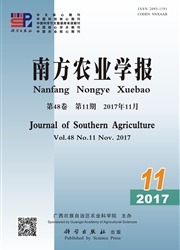

 中文摘要:
中文摘要:
【目的】探讨CFDA荧光染色技术检测高温细菌的效果,阐明木薯酒精渣堆肥过程中的细菌动态,为堆肥进程的调节和评价提供依据。【方法】在30℃和60℃下对高温型和中温型细菌进行CFDA荧光染色,观察染色效果。同时采用CFDA技术和培养法对木薯酒精渣堆肥中的细菌动态和垂直分布进行监测。【结果】60℃下进行CFDA荧光染色能有效识别高温细菌。CFDA技术检测结果显示,木薯渣堆肥前期堆料中细菌以中温型为主,但随堆肥时间延长,数量逐渐减少;高温型细菌数量随堆肥时间延长迅速增加,并在发酵后期成为优势菌群。10-40cm深度的堆料温度高,细菌以高温型为主;50cm以下堆料呈酸性,温度降低,细菌以中温型为主。【结论】高温细菌是木薯酒精渣高温堆肥中的重要微生物群体,CFDA荧光染色技术可以检测出高温细菌,可用于检测木薯渣堆肥中的总高温细菌数量。
 英文摘要:
英文摘要:
[Objective ]The present study aimed to determine the efficiency of CFDA fluorescent staining technique on detecting thermophilic bacteria in order to clarify the bacteria quantity changes during cassava residue compost and to pro- vide a basis for regulating and evaluating the composing process. [ Method ] Both thermophilic and mesophilic bacteria were detected by CFDA fluorescent staining under 30℃ and 60℃, and their staining effects were observed. Both the CFDA technique and plate count method were adopted simultaneously to monitor the dynamic changes in the quantity and vertical distribution of bacteria in cassava residue compost. [Result]The CFDA technique could identify thermophilie bacteria ef- fectively under 60℃. Data from CFDA technique showed that, during the cassava residue compost detection, mesophilic bacteria were quantitatively predominant at early stage, but decreased as the time of detection increased; on the other hand, the amount of thermophilic bacteria increased rapidly as time increased and became the predominant bacteria vari- ety at the late fermentation stage. The highest temperature was detected when the compost pile measured at the depth of 10-40 cm, in which the thermophilic bacteria were predominant; in the bottom half of the compost pile, the temperature decreased, pH level turned acidic, and mesophilic bacteria became the predominant bacteria variety. [Conclusion]Ther- mophilic bacteria were the predominant microbial group in the high temperature compost of cassava residue, and the CF- DA technique could be used for the accurate evaluation of the bacteria group.
 同期刊论文项目
同期刊论文项目
 同项目期刊论文
同项目期刊论文
 期刊信息
期刊信息
